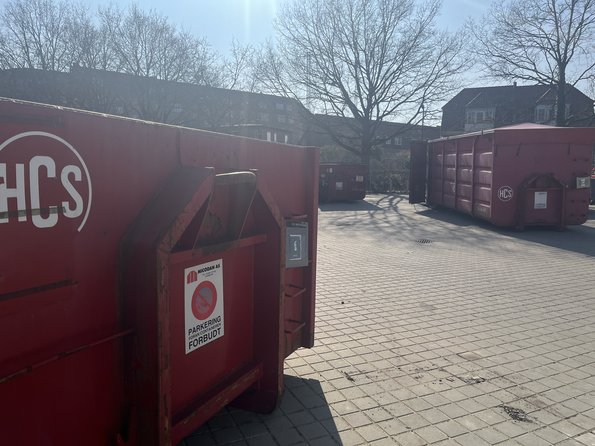Waste Sorting at AU: Say Goodbye to All-in-One Bins
At home, we’ve been sorting our waste into ten different categories for years. However, at several locations atAU, all the rubbish still goes into the same bin, despite the waste sorting requirement that has been in place since January 2023. Now, the university is rolling out a new waste sorting system, which is expected to be fully implemented by this summer.

Waste sorting at AU
According to Aarhus University, the university produces around 1,200 tons of waste annually.
Since January 1, 2023, workplaces and public institutions have been required to sort waste according to the same criteria as private households.
The plan is for all AU locations to implement waste sorting by the summer of 2025.
While we diligently sort our waste into ten different categories at home, it’s not yet as straightforward to dispose of rubbish at AU. Everything still goes into one bin—whether it's plastic or organic waste. This is despite the fact that companies have been required to sort waste into up to ten categories since January 2023.
One of the staff members who has questioned why Aarhus University hasn’t made more progress in implementing waste sorting is Søren Møller Dath, Head of the Technical Laboratory at the Department of Electrical and Computer Engineering and vice chairman of the department’s local committee on occupational health and safety (LAMU).
‘Where I work, all the waste still goes into the same garbage bag. We've discussed it several times at LAMU over the past two years, asking for an update on the status of waste sorting,’ says Søren Møller Dath. He continues,
“I find it strange that the university, as an institution, doesn’t take the lead in waste sorting when we, as private individuals, have been doing it for years”.
Back in 2023, AU expected that the implementation of a new sorting system could start in early 2024. However, here at the beginning of 2025, a new sorting system has still not been fully implemented across all departments at AU.
This is because implementing waste sorting in a large organisation like Aarhus University, which generates significant amounts of waste, is far from a trivial task, says Charlotte Lyngholm Bom, Head of Campus Development at Aarhus University. Additionally, the university has been waiting for detailed reports from Aarhus Municipality regarding waste sorting, she adds.
“It’s a big puzzle to get it all to work,” she says, emphasising that Aarhus University has been sorting waste for several years. What’s new is that all waste now needs to be sorted into ten different categories – or fractions.
“This means we need to set up even more bins than before and finding space for them has been a challenge. We make such efficient use of our buildings that there has been no room to place additional containers inside – and since we don’t want to overcrowd the University Park with bins, we decided to create a designated area for them in the southern part of the park. This area had to be operational, which it now is, before we could start sorting inside the buildings,” she says.
A similar solution must now be established at Katrinebjerg, which can be upscaled as the university campus on Katrinebjerg grows, she says.
“We've got a temporary solution ready that will work for the time being,” she says.
Additionally, both the purchase of new garbage bins for the buildings and the renovation work to manage waste at the university had to be put out to tender. A thorough assessment was required to define the specifications for the tender. This involved determining the amount and types of waste generated at various locations, as well as considering operational procedures for daily waste management and cleaning within the buildings.
“It’s a chain reaction of tasks that have to fall into place before we can roll out the sorting on a large scale,” says Charlotte Lyngholm Bom. However, she stresses that some departments have made significant progress because local solutions have already been implemented, for example, in Herning, Emdrup, Nobel Park, and large parts of University Park.
Charlotte Lyngholm Bom says that the plan is for the waste sorting system to be fully implemented by this summer. The next step is for staff and students to learn how to sort the waste correctly.
“We are no better than the individual user,” she says, explaining that the implementation of waste sorting will be accompanied by an awareness campaign.
Variations across faculties
There is a difference in how far along the implementation of waste sorting is across AU.
The Faculties of Natural Sciences and Technical Sciences have decided to wait until the infrastructure for emptying waste containers is fully established, says Claus Jørgensen, Head of Operations at the Nat-Tech Administration Centre.
Waste management company HCS won the contract to pick up garbage at AU, and the company’s red garbage trucks have started emptying containers across AU in February. At the same time, more containers have been set up than before for the different types of waste.
“The containers and collection system must be in place before we ask staff and students to sort their waste. We don’t want to risk them sorting it, only for it to end up in the same container,” says Claus Jørgensen.
"Once this is in place, we will go through the buildings, institute by institute, to determine where the sorting systems should be installed. As soon as the systems are in place, we will move on to the next institute. With 300,000 square metres of buildings to cover, some patience will be required. However, I expect we will complete the process by summer," says Claus Jørgensen.
“After that, we need to involve the users to ensure they put the waste in the right bins”.
Claus Jørgensen explains that waste sorting is already well established at the faculty departments in Viborg and Roskilde, where HCS has been handling waste collection for some time.
Health is doing “fairly well”
Health has made more progress with the implementation in the 100,000 square metre building area. The new bins are already in place around the buildings, and cooperation with the new supplier, HCS, is underway, says Operations Manager Michael Thyrri Ammitzbøll.
“We're doing fairly well,” he says.
Health plays a special role in waste management in and around University Park, as the Parks and Gardens Section, which is organisationally part of the Health Administrative Centre, will be responsible for picking up waste in several places in the park and driving it to the new renovation site in the southern part of the University Park.
“The Parks and Gardens Section has been expanded with two additional staff members, and the gardeners are responsible for picking up some of the waste fractions in the park, while HCS oversees others. This should help reduce the need for heavy vehicles to drive inside the park itself,” he explains.
In this context, the Waste app is also used, which is intended to streamline the emptying of containers, so that emptying only occurs when it is needed, says Michael Thyrri Ammitzbøll.
In the coming months, everything will be put to the test, and staff and students will also have to get used to sorting. Residual waste, plastic/drink cartons, glass and organic waste must be sorted into bins, which are then emptied by cleaning staff. However, cardboard, paper, flamingo and IT waste must be handled by individual staff, who must carry the waste down into the building's waste storage room. So here, a short walk is required to dispose of the waste.
“Some people will need to get used to the new reality, but we’re trying to ease the transition with an information campaign. It’s the responsibility of each staff member and student to ensure that the waste is sorted correctly,” he emphasises.
Arts moved fast – maybe too fast
At Arts, waste sorting has been implemented since autumn 2024, except for Trøjborgvej, where waste sorting was introduced at the turn of the year, says Operations Manager Mike Brorson Christensen.
However, with the choice of HCS as the supplier, glass and metal must be sorted separately. Therefore, Arts now needs to start dividing the bins so that metal and plastic are sorted individually, rather than together.
“The change of supplier in the middle of the process has caused some challenges,” notes Mike Brorson Christensen.
"I can see the logic in some faculties choosing to wait for the implementation of the new supplier," he says.
At Arts, the bins are set up with the principle that it should be easy for users to dispose of their waste.
“Because if it’s too difficult, people won’t do it. We’ll evaluate the situation but give it some time to see if sorting creates difficulties in certain areas. There’s no definitive answer to this; it will need to be adjusted as necessary. Our cleaning staff empties the bins daily, and in doing so, they’ll also be able to identify any challenges – for example, bins that are not being used, or others that are filling up too quickly," he says.
The other faculties will also evaluate the sorting, the other operational managers inform.
Søren Møller Dath understands that Aarhus University is a large organisation, and a lot of considerations have had to be taken into account during the process.
“But I still think it's been a long time we've had to wait for the implementation. And at the very least, it would have been nice to have had more information about the process,” he says.
This text is machine translated and post-edited by Cecillia Jensen.




